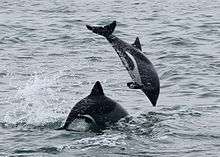Heaviside's dolphin
Heaviside's dolphin (Cephalorhynchus heavisidii), sometimes called Haviside's dolphin after its discoverer, is a small dolphin found from the southern coasts of Angola to the Cape of Good Hope. It is one of four dolphins in the genus Cephalorhynchus — the others being the Chilean dolphin, Hector's dolphin, and Commerson's dolphin.
| Heaviside's dolphin | |
|---|---|
.jpg) | |
| Heaviside's dolphin off Lüderitz | |
 | |
| Size compared to an average human | |
| Scientific classification | |
| Kingdom: | Animalia |
| Phylum: | Chordata |
| Class: | Mammalia |
| Order: | Artiodactyla |
| Infraorder: | Cetacea |
| Family: | Delphinidae |
| Genus: | Cephalorhynchus |
| Species: | C. heavisidii |
| Binomial name | |
| Cephalorhynchus heavisidii Gray, 1828 | |
| Heaviside's dolphin range | |
Name
Early in the 19th century, a specimen was caught off the Cape of Good Hope and brought to the United Kingdom by a Captain Haviside of the British East India Company. Zoologist John Edward Gray, who described the species in his Spicilegia Zoologica, misidentified Haviside as the surgeon John Heaviside, whose collection was acquired roughly contemporaneously.[2][3][4][5] "Heaviside's Dolphin" is most common in the literature, though some authorities use the originally intended name "Haviside's dolphin".
Population and distribution
Although sightings of the species are not uncommon off the Skeleton Coast of Namibia, Heaviside's dolphins have not been systematically studied by scientists. They have been recorded off the coast of northern Namibia at 17°S and as far south as the southern tip of South Africa. Sightings are often recorded from major population centres such as Cape Town and towns such as Walvis Bay. Sightings are likely from Lambert's Bay either from the shore or from boat trips run from the harbour. No estimates of abundance exist.
Physical description

Heaviside's dolphin is a fairly small dolphin, growing to about 1.8 m (5 ft 11 in) in length and weighing up to 75 kg (165 lb). Their size and the bluntness of their heads lead these dolphins to often be mistaken for porpoises. The head is coloured a dark grey. The front half of the upper side and the flanks are a much lighter grey.[6] The dorsal fin, fluke and back half of the back are again a darker grey colour. The underbelly is white, with flashes of white on the flanks below the dorsal fin.
Males reach sexual maturity around 7 to 9 years old. Females reach breeding age at the same time. The gestation period is probably 10 months. Mating occurs in spring and summer. Females are believed to calve on average once every three years. The maximum known age of a Heaviside's dolphin is 20 years. This relatively short lifespan, coupled with the long calving period, causes a naturally low population growth rate. Therefore, the species is particularly sensitive to being hunted.
Heaviside's dolphins are active and social animals. They typically congregate in groups of about five to 10 in number, but sometimes in larger groups. They are able to swim fast. Part of their play and social activity is to jump vertically clear of the water, turn in the air, and fall back into the sea with virtually no splashing or noise.
Conservation
Heaviside's dolphin is listed on Appendix II[7] of the Convention on the Conservation of Migratory Species of Wild Animals. It is listed on Appendix II[7] as it has an unfavourable conservation status or would benefit significantly from international co-operation organised by tailored agreements.[8]
Heaviside's dolphin is covered by the Memorandum of Understanding Concerning the Conservation of the Manatee and Small Cetaceans of Western Africa and Macaronesia.[9]
See also
References
- Elwen, S.; Gopal, K. (2018), "Heaviside's Dolphin, Cephalorhynchus heavisidii", The IUCN Red List of Threatened Species 2018: e.T4161A50352086, doi:10.2305/IUCN.UK.2018-2.RLTS.T4161A50352086.en, retrieved 18 December 2018
- National Audubon Society Guide to Marine Mammals of the World. A.A. Knopf. 2002. p. 337. ISBN 978-0-375-41141-0.
- Platt, John R. (9 May 2014). "First Major Genetic Study of Elusive South African Dolphin Reveals a Species in Peril". Scientific American. Retrieved 10 December 2015.
- Gray, John Edward (1828). Spicilegia Zoologica, , or original figures and short systematic descriptions of new and unfigured animals Pt 1. London: Treuttel, Würtz & Co. p. 2.
- Norris, Kenneth Stafford (1966). Whales, Dolphins, and Porpoises. p. 17. ISBN 9780520032835.
- Perrin, W. F. (2002). Encyclopedia of Marine Mammals. Gulf Professional Publishing. p. 265. ISBN 978-0-12-551340-1.
- "Appendices I and II of the Convention on the Conservation of Migratory Species of Wild Animals (CMS)" (PDF). 5 March 2009. p. 6. Archived from the original (PDF) on 21 February 2012.
- "Cephalorhynchus heavisidii (Gray, 1828)". Convention on Migratory Species. Archived from the original on 2 April 2012. Retrieved 31 August 2011.
- "Cephalorhynchus heavisidii". Convention on the Conservation of Migratory Species of Wild Animals. Retrieved 13 January 2020.
External links
- Heaviside's dolphin at the Encyclopedia of the Earth.
